Risk Assessment and Spatiotemporal Variation of Microplastic Concentration, Size, and Polymer Type in Mayotte Lagoon’s Surface Water (Comoros Archipelagos)
Abstract
1. Introduction
2. Materials and Methods
2.1. Study Area
2.2. Sampling and Handling
2.3. Laboratory Analysis
2.3.1. Extraction and Density Separation Steps
2.3.2. FTIR Analysis
2.4. Quality Control
2.5. Statistics
2.6. Microplastic Risk Assessment
2.6.1. Pollution Load Index (PLI)
2.6.2. Polymer Risk Assessment Index H
2.6.3. Potential Ecological Risk Index RI
3. Results and Discussion
3.1. Baseline Concentrations of Microplastics in Surface Water
3.1.1. Baseline Concentrations
3.1.2. Seasonal Concentration Variations
3.1.3. Microplastic Polymer Concentrations
3.2. Microplastic Size Distribution in the Lagoon Surface Water
3.3. Spatial Microplastic Distribution in Lagoon Surface Water: Effects of Season and Hydrodynamic Features
3.4. Microplastic Ecological Risk Assessment in Lagoon Surface Water
4. Conclusions
Supplementary Materials
Author Contributions
Funding
Institutional Review Board Statement
Informed Consent Statement
Data Availability Statement
Acknowledgments
Conflicts of Interest
Abbreviations
| MP | Microplastics |
| µFTIR | Micro-Fourier-transform infrared spectroscopy |
| PE | Polyethylene |
| PP | Polypropylene |
| PET | Polyethylene terephthalate |
| PS | Polystyrene |
| PA | Polyamide |
| PVC | Polyvinyl chloride |
| PC | Polycarbonate |
| EVA | Ethylene-vinyl acetate |
| PCA | Principal component analysis |
References
- Frias, J.P.G.L.; Nash, R. Microplastics: Finding a Consensus on the Definition. Mar. Pollut. Bull. 2019, 138, 145–147. [Google Scholar] [CrossRef] [PubMed]
- Zhang, Y.; Gao, T.; Kang, S.; Shi, H.; Mai, L.; Allen, D.; Allen, S. Current Status and Future Perspectives of Microplastic Pollution in Typical Cryospheric Regions. Earth-Sci. Rev. 2022, 226, 103924. [Google Scholar] [CrossRef]
- Gao, S.; Orlowski, N.; Bopf, F.K.; Breuer, L. A Review on Microplastics in Major European Rivers. WIREs Water 2024, 11, e1713. [Google Scholar] [CrossRef]
- Phuong, N.N.; Duong, T.T.; Le, T.P.Q.; Hoang, T.K.; Ngo, H.M.; Phuong, N.A.; Pham, Q.T.; Doan, T.O.; Ho, T.C.; Da Le, N.; et al. Microplastics in Asian Freshwater Ecosystems: Current Knowledge and Perspectives. Sci. Total Environ. 2022, 808, 151989. [Google Scholar] [CrossRef]
- Zhu, J.; Dong, G.; Feng, F.; Ye, J.; Liao, C.-H.; Wu, C.-H.; Chen, S.-C. Microplastics in the Soil Environment: Focusing on the Sources, Its Transformation and Change in Morphology. Sci. Total Environ. 2023, 896, 165291. [Google Scholar] [CrossRef] [PubMed]
- Pinheiro, M.; Martins, I.; Raimundo, J.; Caetano, M.; Neuparth, T.; Santos, M.M. Stressors of Emerging Concern in Deep-Sea Environments: Microplastics, Pharmaceuticals, Personal Care Products and Deep-Sea Mining. Sci. Total Environ. 2023, 876, 162557. [Google Scholar] [CrossRef]
- Sharma, S.; Bhardwaj, A.; Thakur, M.; Saini, A. Understanding Microplastic Pollution of Marine Ecosystem: A Review. Environ. Sci. Pollut. Res. 2023, 31, 41402–41445. [Google Scholar] [CrossRef] [PubMed]
- Shao, L.; Li, Y.; Jones, T.; Santosh, M.; Liu, P.; Zhang, M.; Xu, L.; Li, W.; Lu, J.; Yang, C.-X.; et al. Airborne Microplastics: A Review of Current Perspectives and Environmental Implications. J. Clean. Prod. 2022, 347, 131048. [Google Scholar] [CrossRef]
- Truong, T.-N.-S.; Strady, E.; Kieu-Le, T.-C.; Tran, Q.-V.; Le, T.-M.-T.; Thuong, Q.-T. Microplastic in Atmospheric Fallouts of a Developing Southeast Asian Megacity under Tropical Climate. Chemosphere 2021, 272, 129874. [Google Scholar] [CrossRef]
- Wang, C.; O’Connor, D.; Wang, L.; Wu, W.-M.; Luo, J.; Hou, D. Microplastics in Urban Runoff: Global Occurrence and Fate. Water Res. 2022, 225, 119129. [Google Scholar] [CrossRef]
- Guo, J.-J.; Huang, X.-P.; Xiang, L.; Wang, Y.-Z.; Li, Y.-W.; Li, H.; Cai, Q.-Y.; Mo, C.-H.; Wong, M.-H. Source, Migration and Toxicology of Microplastics in Soil. Environ. Int. 2020, 137, 105263. [Google Scholar] [CrossRef] [PubMed]
- Waldschläger, K.; Born, M.; Cowger, W.; Gray, A.; Schüttrumpf, H. Settling and Rising Velocities of Environmentally Weathered Micro- and Macroplastic Particles. Environ. Res. 2020, 191, 110192. [Google Scholar] [CrossRef]
- Iqbal, B.; Zhao, T.; Yin, W.; Zhao, X.; Xie, Q.; Khan, K.Y.; Zhao, X.; Nazar, M.; Li, G.; Du, D. Impacts of Soil Microplastics on Crops: A Review. Appl. Soil Ecol. 2023, 181, 104680. [Google Scholar] [CrossRef]
- Kalčíková, G. Beyond Ingestion: Adhesion of Microplastics to Aquatic Organisms. Aquat. Toxicol. 2023, 258, 106480. [Google Scholar] [CrossRef] [PubMed]
- Parolini, M.; Stucchi, M.; Ambrosini, R.; Romano, A. A Global Perspective on Microplastic Bioaccumulation in Marine Organisms. Ecol. Indic. 2023, 149, 110179. [Google Scholar] [CrossRef]
- Doyle, D.; Sundh, H.; Almroth, B.C. Microplastic Exposure in Aquatic Invertebrates Can Cause Significant Negative Effects Compared to Natural Particles—A Meta-Analysis. Environ. Pollut. 2022, 315, 120434. [Google Scholar] [CrossRef]
- Wang, C.; Zhao, J.; Xing, B. Environmental Source, Fate, and Toxicity of Microplastics. J. Hazard. Mater. 2021, 407, 124357. [Google Scholar] [CrossRef]
- Prata, J.C.; da Costa, J.P.; Lopes, I.; Duarte, A.C.; Rocha-Santos, T. Environmental Exposure to Microplastics: An Overview on Possible Human Health Effects. Sci. Total Environ. 2020, 702, 134455. [Google Scholar] [CrossRef]
- Prata, J.C. Microplastics and Human Health: Integrating Pharmacokinetics. Crit. Rev. Environ. Sci. Technol. 2023, 53, 1489–1511. [Google Scholar] [CrossRef]
- Owens, E.L.; Zhang, Q.; Mihelcic, J.R. Material Flow Analysis Applied to Household Solid Waste and Marine Litter on a Small Island Developing State. J. Environ. Eng. 2011, 137, 937–944. [Google Scholar] [CrossRef]
- Guillotreau, P.; Antoine, S.; Kante, F.; Perchat, K. Quantifying Plastic Use and Waste Footprints in SIDS: Application to Seychelles. J. Clean. Prod. 2023, 417, 138018. [Google Scholar] [CrossRef]
- Singh, S.J.; Elgie, A.; Noll, D.; Eckelman, M.J. The Challenge of Solid Waste on Small Islands: Proposing a Socio-Metabolic Research (SMR) Framework. Curr. Opin. Environ. Sustain. 2023, 62, 101274. [Google Scholar] [CrossRef]
- Burt, A.J.; Raguain, J.; Sanchez, C.; Brice, J.; Fleischer-Dogley, F.; Goldberg, R.; Talma, S.; Syposz, M.; Mahony, J.; Letori, J.; et al. The Costs of Removing the Unsanctioned Import of Marine Plastic Litter to Small Island States. Sci. Rep. 2020, 10, 14458. [Google Scholar] [CrossRef]
- Onyena, A.P.; Aniche, D.C.; Ogbolu, B.O.; Rakib, M.R.J.; Uddin, J.; Walker, T.R. Governance Strategies for Mitigating Microplastic Pollution in the Marine Environment: A Review. Microplastics 2022, 1, 15–46. [Google Scholar] [CrossRef]
- Mulochau, T.; Lelabousse, C.; Séré, M. Estimations of Densities of Marine Litter on the Fringing Reefs of Mayotte (France—South Western Indian Ocean)—Impacts on Coral Communities. Mar. Pollut. Bull. 2020, 160, 111643. [Google Scholar] [CrossRef] [PubMed]
- Li, W.C.; Tse, H.F.; Fok, L. Plastic Waste in the Marine Environment: A Review of Sources, Occurrence and Effects. Sci. Total Environ. 2016, 566–567, 333–349. [Google Scholar] [CrossRef]
- Ifremer Système d’Informations Halieutiques. Quartier Maritime Dzaoudzi. 2021. Activité Des Navires de Pêche; 2022. Available online: https://archimer.ifremer.fr/doc/00874/98578/ (accessed on 25 April 2025).
- INSEE. À Mayotte, Un Recensement Adapté à Une Population Aux Évolutions Hors Normes; 2023. Available online: https://www.insee.fr/fr/information/6687468 (accessed on 25 April 2025).
- Foucher, A.; Evrard, O.; Rabiet, L.; Cerdan, O.; Landemaine, V.; Vitter, M.; Desprats, J.-F. Impact of Rapid Deforestation and Conversion of Traditional Agricultural Practices into Food Crop Production on Land and Water Degradation: A Case Study from Mayotte Island, Indian Ocean, France (2011–2022). In Proceedings of the Copernicus Meetings, Brussels, Belgium, 5–9 June 2023. [Google Scholar]
- Gourbesville, P.; Thomassin, B.A. Coastal Environment Assessment Procedure for Sustainable Wastewater Management in Tropical Islands: The Mayotte Example. Ocean Coast. Manag. 2000, 43, 997–1014. [Google Scholar] [CrossRef]
- Nicolle, P.; Lebecherel, L.; Perrin, C.; Delaigue, O. Détermination de Valeurs Seuils Sécheresse Pour Les Eaux de Surface Du Département de Mayotte—Rapport Final. IRSTEA <hal.Inrae.Fr/Hal-02606202>; 2016; 95p. Available online: https://www.inrae.fr/ (accessed on 25 April 2025).
- Trégarot, E.; Failler, P.; Maréchal, J.-P. Evaluation of Coastal and Marine Ecosystem Services of Mayotte: Indirect Use Values of Coral Reefs and Associated Ecosystems. Int. J. Biodivers. Sci. Ecosyst. Serv. Manag. 2017, 13, 19–34. [Google Scholar] [CrossRef]
- Schott, F.A.; McCreary, J.P. The Monsoon Circulation of the Indian Ocean. Prog. Oceanogr. 2001, 51, 1–123. [Google Scholar] [CrossRef]
- Chevalier, C.; Devenon, J.L.; Pagano, M.; Rougier, G.; Blanchot, J.; Arfi, R. The Atypical Hydrodynamics of the Mayotte Lagoon (Indian Ocean): Effects on Water Age and Potential Impact on Plankton Productivity. Estuar. Coast. Shelf Sci. 2017, 196, 182–197. [Google Scholar] [CrossRef]
- GESAMP. Guidelines or the Monitoring and Assessment of Plastic Litter and Microplastics in the Ocean; IMO/FAO/UNESCO-IOC/UNIDO/WMO/IAEA/UN/UNEP/UNDP/ISA Joint Group of Experts on the Scientific Aspects of Marine Environmental Protection; GESAMP: Paris, France, 2019; p. 130. [Google Scholar]
- Strady, E.; Dang, T.H.; Dao, T.D.; Dinh, H.N.; Do, T.T.D.; Duong, T.N.; Duong, T.T.; Hoang, D.A.; Kieu-Le, T.C.; Le, T.P.Q.; et al. Baseline Assessment of Microplastic Concentrations in Marine and Freshwater Environments of a Developing Southeast Asian Country, Viet Nam. Mar. Pollut. Bull. 2021, 162, 111870. [Google Scholar] [CrossRef] [PubMed]
- Dehaut, A.; Hermabessiere, L.; Duflos, G. Current Frontiers and Recommendations for the Study of Microplastics in Seafood. TrAC Trends Anal. Chem. 2019, 116, 346–359. [Google Scholar] [CrossRef]
- Shabaka, S.; Moawad, M.N.; Ibrahim, M.I.A.; El-Sayed, A.A.M.; Ghobashy, M.M.; Hamouda, A.Z.; El-Alfy, M.A.; Darwish, D.H.; Youssef, N.A.E. Prevalence and Risk Assessment of Microplastics in the Nile Delta Estuaries: “The Plastic Nile” Revisited. Sci. Total Environ. 2022, 852, 158446. [Google Scholar] [CrossRef] [PubMed]
- Kosore, C.M.; Ojwang, L.; Maghanga, J.; Kamau, J.; Shilla, D.; Everaert, G.; Khan, F.R.; Shashoua, Y. Microplastics in Kenya’s Marine Nearshore Surface Waters: Current Status. Mar. Pollut. Bull. 2022, 179, 113710. [Google Scholar] [CrossRef]
- Lithner, D.; Larsson, Å.; Dave, G. Environmental and Health Hazard Ranking and Assessment of Plastic Polymers Based on Chemical Composition. Sci. Total Environ. 2011, 409, 3309–3324. [Google Scholar] [CrossRef]
- Nchimbi, A.A.; Kosore, C.M.; Oduor, N.; Shilla, D.J.; Shashoua, Y.; Khan, F.R.; Shilla, D.A. Microplastics in Marine Nearshore Surface Waters of Dar Es Salaam and Zanzibar, East Africa. Bull. Environ. Contam. Toxicol. 2022, 109, 1037–1042. [Google Scholar] [CrossRef]
- Hildebrandt, L.; El Gareb, F.; Zimmermann, T.; Klein, O.; Kerstan, A.; Emeis, K.-C.; Pröfrock, D. Spatial Distribution of Microplastics in the Tropical Indian Ocean Based on Laser Direct Infrared Imaging and Microwave-Assisted Matrix Digestion. Environ. Pollut. 2022, 307, 119547. [Google Scholar] [CrossRef]
- Baek, E.-R.; Kim, M.; Kang, D.-J.; Kang, J.-H. Distribution Characteristics of Microplastics in the Surface Mixed Layer of the Western Indian Ocean. Deep Sea Res. Part II Top. Stud. Oceanogr. 2024, 218, 105424. [Google Scholar] [CrossRef]
- Saliu, F.; Montano, S.; Garavaglia, M.G.; Lasagni, M.; Seveso, D.; Galli, P. Microplastic and Charred Microplastic in the Faafu Atoll, Maldives. Mar. Pollut. Bull. 2018, 136, 464–471. [Google Scholar] [CrossRef]
- Grangeon, T.; Cerdan, O.; Landemaine, V.; Vandromme, R.; Desprats, J.-F.; Salvador-Blanes, S.; Vanhooydonck, P.; Gaillot, A.; Maniere, L.; Pene-Galland, I.; et al. Les Observatoires Du Ruissellement: Comprendre Les Processus Pour Améliorer Les Modélisations. Houille Blanche 2020, 106, 7–16. [Google Scholar] [CrossRef]
- Vacelet, E.; Arnoux, A.; Thomassin, B.A.; Travers, M. Influence of Freshwater and Terrigenous Material on Nutrients, Bacteria and Phytoplankton in a High Island Lagoon: Mayotte, Comoro Archipelago, Indian Ocean. Hydrobiologia 1998, 380, 165–178. [Google Scholar] [CrossRef]
- Han, N.; Zhao, Q.; Ao, H.; Hu, H.; Wu, C. Horizontal Transport of Macro- and Microplastics on Soil Surface by Rainfall Induced Surface Runoff as Affected by Vegetations. Sci. Total Environ. 2022, 831, 154989. [Google Scholar] [CrossRef]
- SIDEVAM 976. Syndicat Intercommunal d’Elimination et de Valorisation Des Déchets de Mayotte; Rapport d’activité 2020; 2022. Available online: https://www.ccomptes.fr/fr/publications/syndicat-intercommunal-delimination-et-de-valorisation-des-dechets-de-mayotte-2 (accessed on 25 April 2025).
- Lahon, J.; Handique, S. Impact of Flooding on Microplastic Abundance and Distribution in Freshwater Environment: A Review. Environ. Sci. Pollut. Res. 2023, 30, 118175–118191. [Google Scholar] [CrossRef]
- Gündoğdu, S.; Çevik, C.; Ayat, B.; Aydoğan, B.; Karaca, S. How Microplastics Quantities Increase with Flood Events? An Example from Mersin Bay NE Levantine Coast of Turkey. Environ. Pollut. 2018, 239, 342–350. [Google Scholar] [CrossRef]
- James, K.; Kripa, V.; Padua, S.; Vineetha, G.; Parvathy, R. Influence of Precipitation and Currents on the Inter and Intra-Annual Fluctuation in the Distribution of Microplastics in the Coastal Environment of Kochi, Eastern Arabian Sea, Southwest Coast of India. Reg. Stud. Mar. Sci. 2025, 81, 103999. [Google Scholar] [CrossRef]
- Xia, W.; Rao, Q.; Deng, X.; Chen, J.; Xie, P. Rainfall Is a Significant Environmental Factor of Microplastic Pollution in Inland Waters. Sci. Total Environ. 2020, 732, 139065. [Google Scholar] [CrossRef]
- Felton, A.; Farner, S.; Day, L.; Gibbs-Huerta, S.E.; Zamarripa, B.; Hutchinson, J. Spatial–Temporal Characterization of Microplastics in the Surface Water of an Urban Ephemeral River. Microplastics 2025, 4, 9. [Google Scholar] [CrossRef]
- Li, C.; Wang, X.; Liu, K.; Zhu, L.; Wei, N.; Zong, C.; Li, D. Pelagic Microplastics in Surface Water of the Eastern Indian Ocean during Monsoon Transition Period: Abundance, Distribution, and Characteristics. Sci. Total Environ. 2021, 755, 142629. [Google Scholar] [CrossRef]
- Naidu, S.A.; Mawii, L.; Ranga Rao, V.; Anitha, G.; Mishra, P.; Narayanaswamy, B.E.; Anil Kumar, V.; Ramana Murthy, M.V.; Gvm, G. Characterization of Plastic Debris from Surface Waters of the Eastern Arabian Sea–Indian Ocean. Mar. Pollut. Bull. 2021, 169, 112468. [Google Scholar] [CrossRef]
- Nikhil, V.G.; Ranjeet, K.; Varghese, G.K. Spatio-Temporal Evaluation and Risk Assessment of Microplastics in Nearshore Surface Waters Post-2018 Kerala Deluge along the Southwest Coast of India. Mar. Pollut. Bull. 2023, 192, 115058. [Google Scholar] [CrossRef]
- Prata, J.C.; da Costa, J.P.; Duarte, A.C.; Rocha-Santos, T. Methods for Sampling and Detection of Microplastics in Water and Sediment: A Critical Review. TrAC Trends Anal. Chem. 2019, 110, 150–159. [Google Scholar] [CrossRef]
- Rehm, R.; Zeyer, T.; Schmidt, A.; Fiener, P. Soil Erosion as Transport Pathway of Microplastic from Agriculture Soils to Aquatic Ecosystems. Sci. Total Environ. 2021, 795, 148774. [Google Scholar] [CrossRef] [PubMed]
- INSEE. 2017 INSEE Analyses N15: 256 500 Habitants à Mayotte En 2017. Available online: https://www.Insee.Fr/Fr/Statistiques/3284395?Sommaire=4199393#consulter (accessed on 25 April 2025).
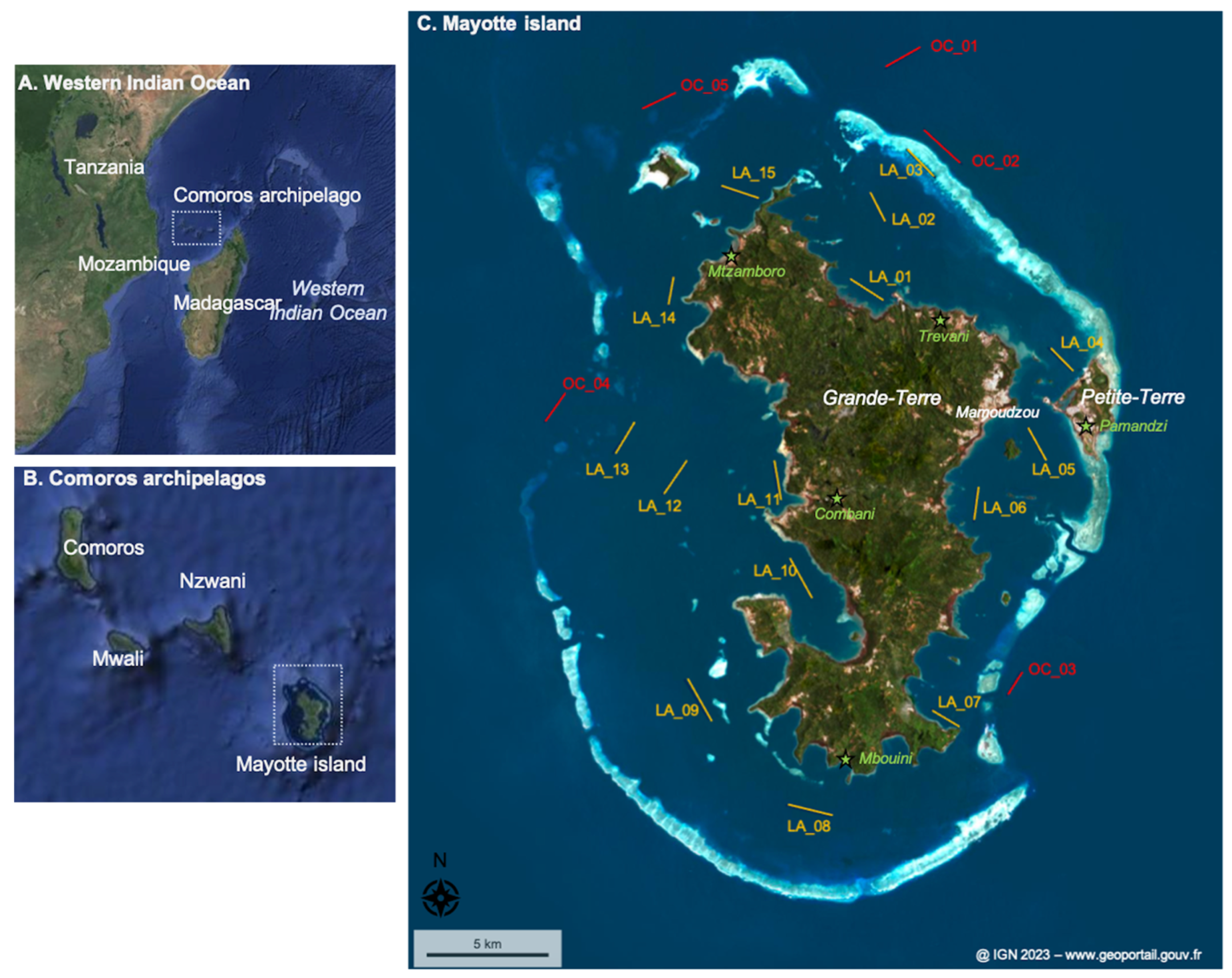
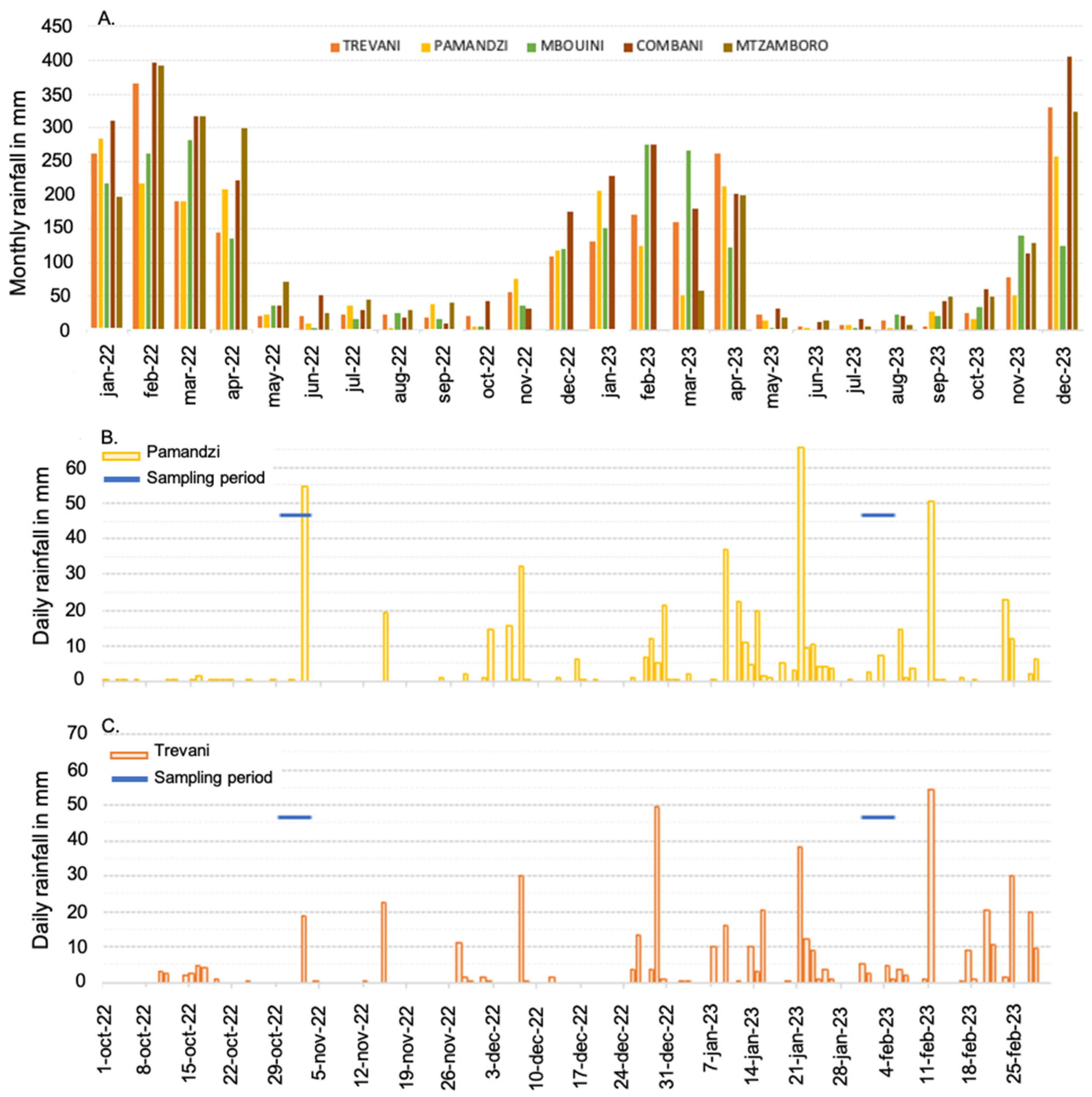
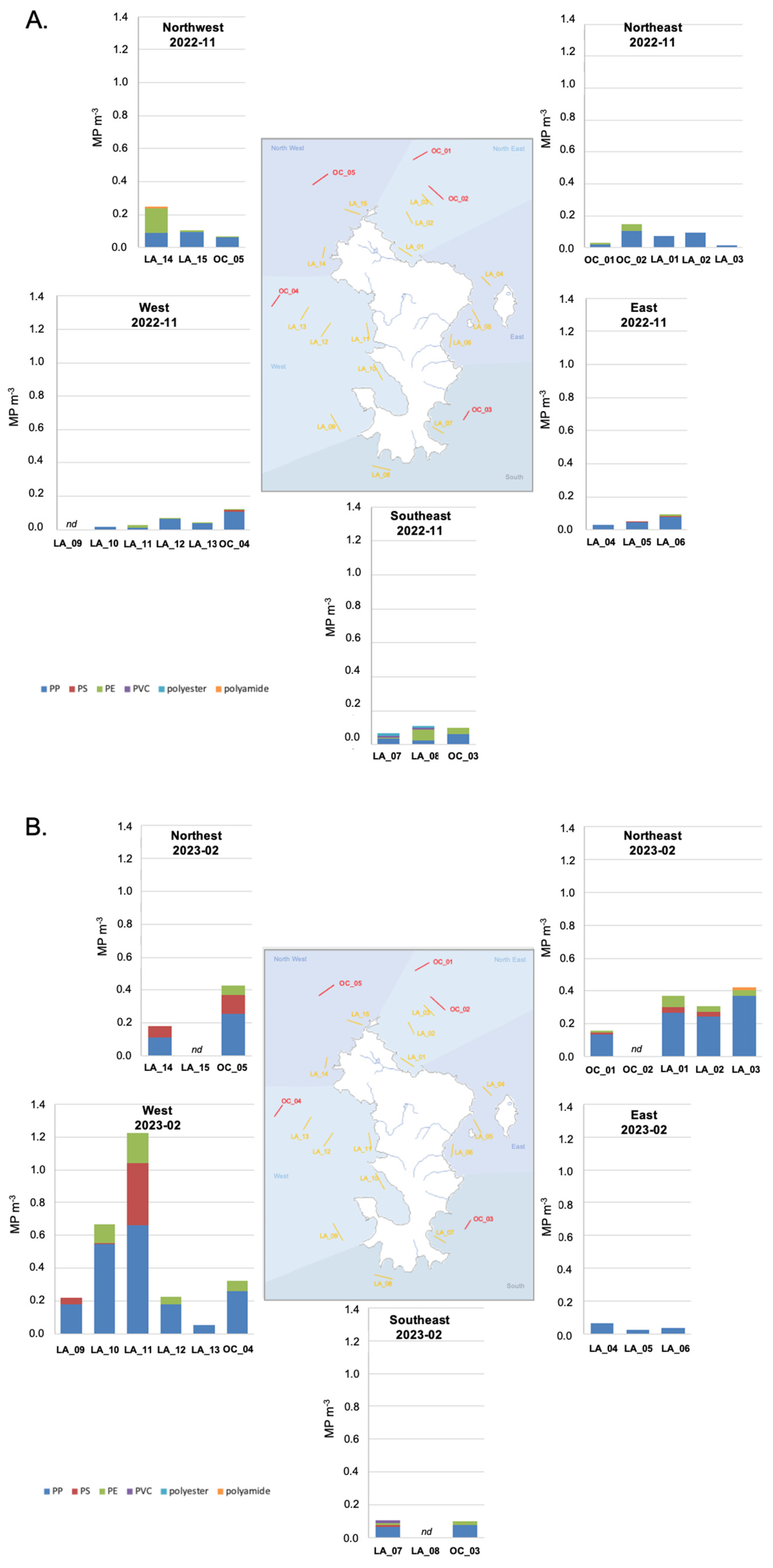
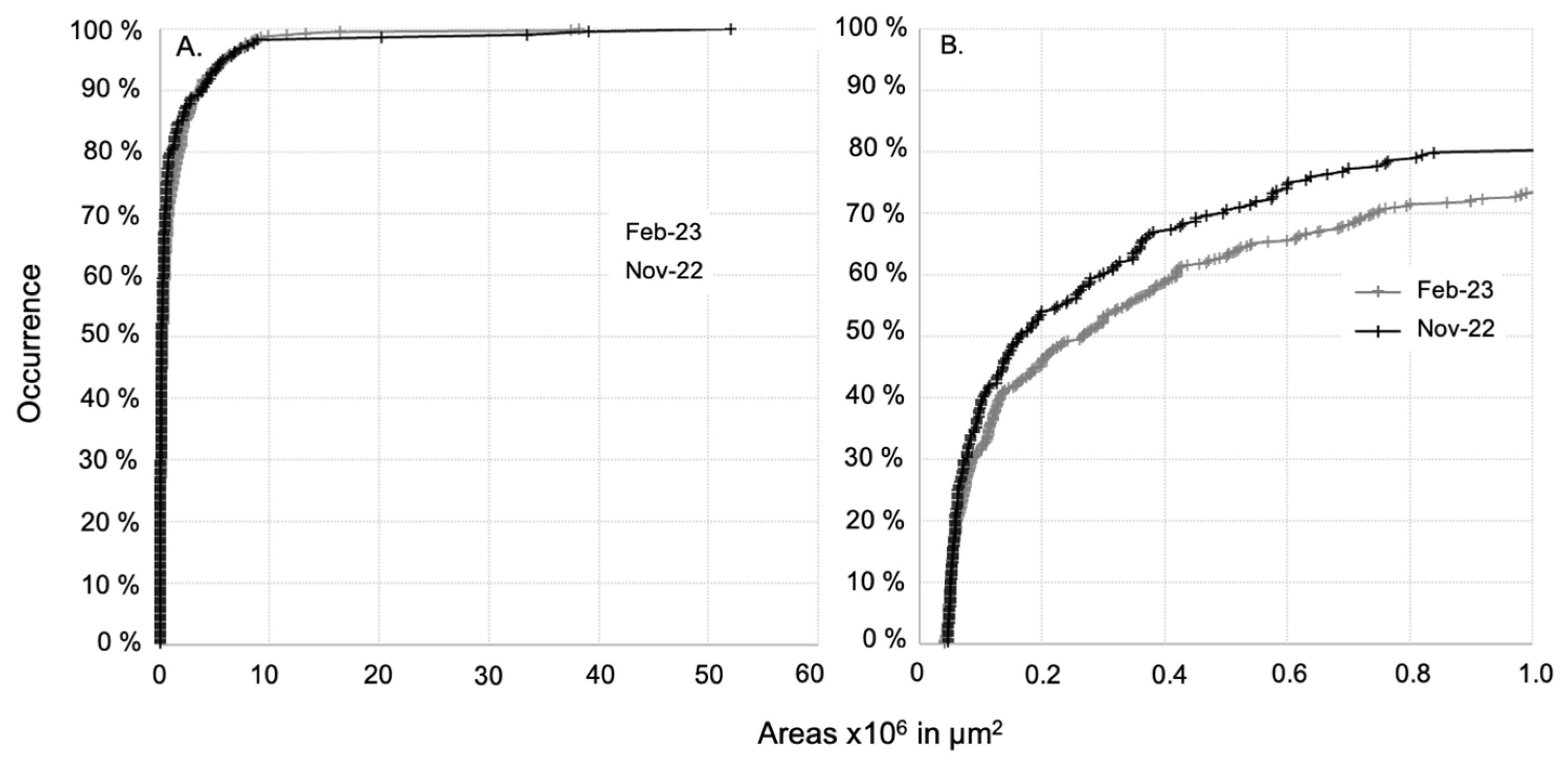
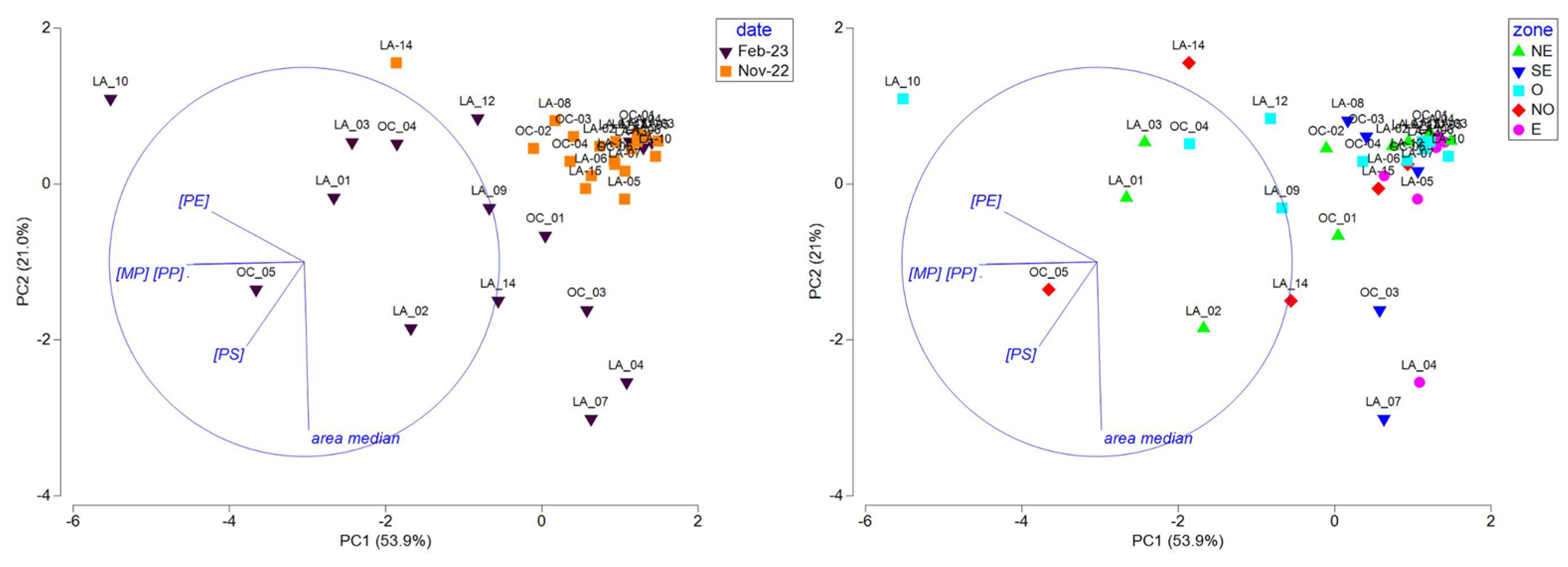
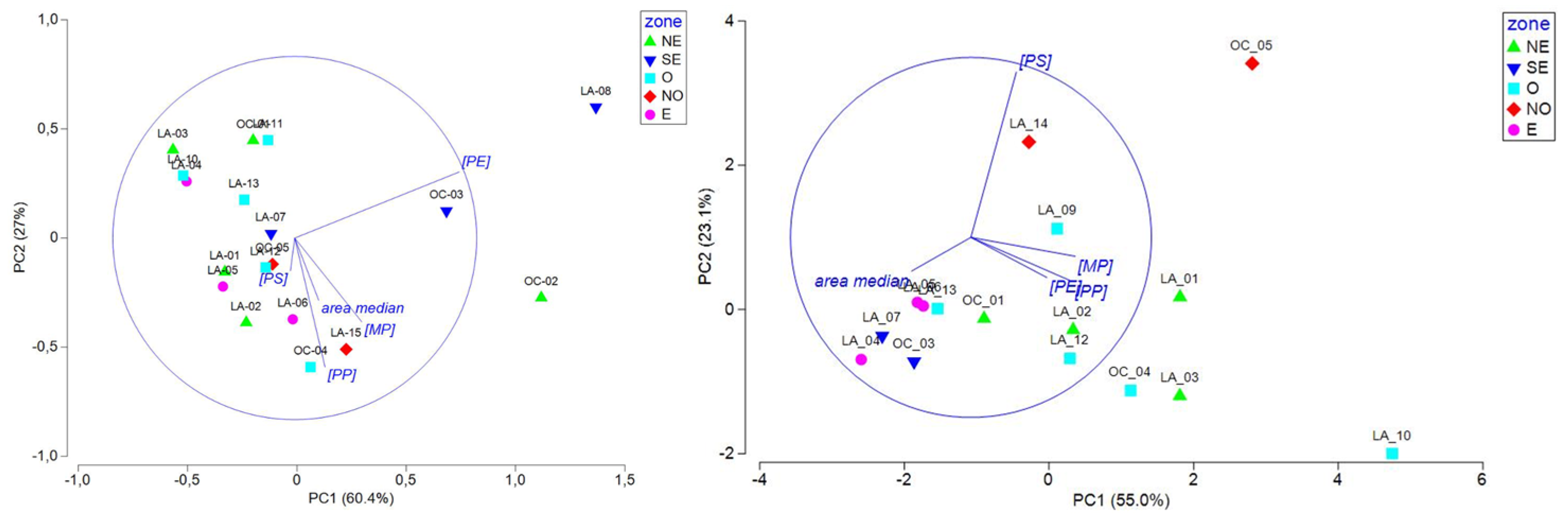
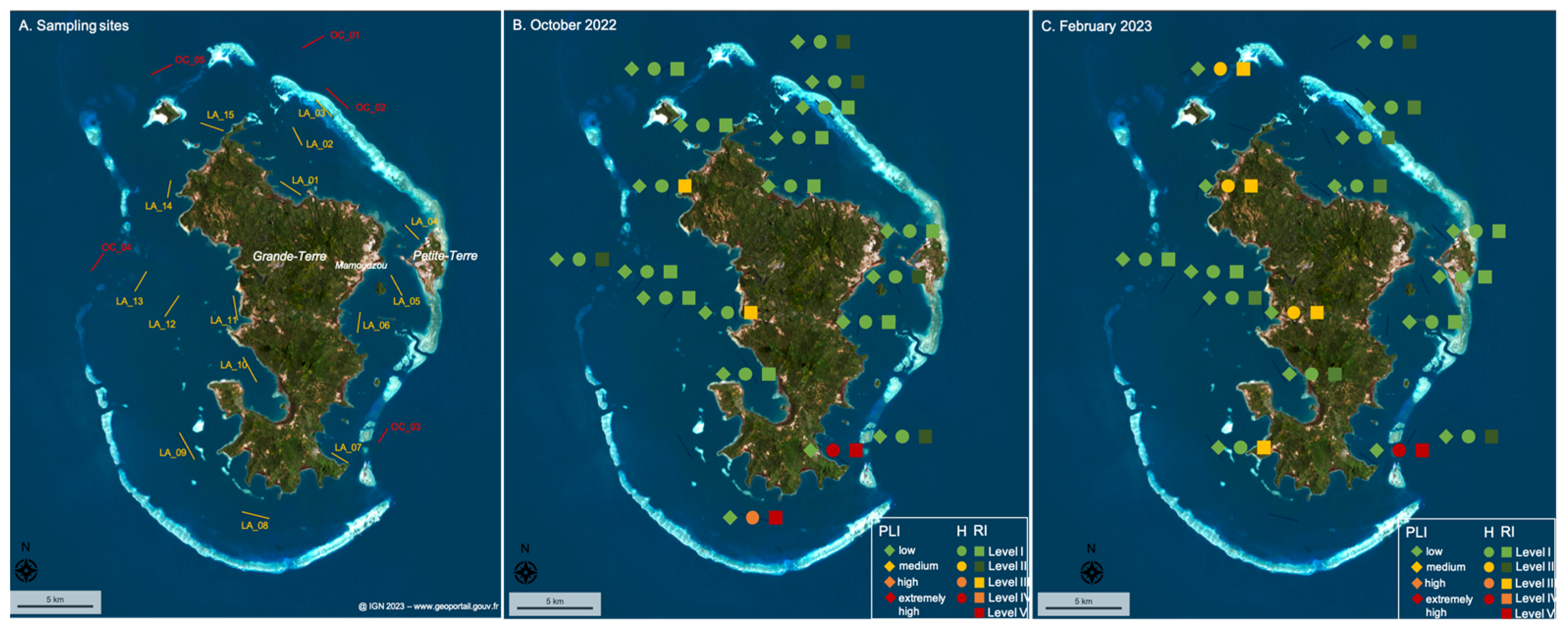
| Site | Location in the Lagoon | Dry Season: October 2022 | Rainy Season: February 2023 | ||
|---|---|---|---|---|---|
| Sampling Date | Vwater sampled m−3 | Sampling Date | Vwater sampled m−3 | ||
| OC_01 | Outside | 3 November 2022 | 164.9 | 31 January 2023 | 95.8 |
| OC_01 | Outside | 29 October 2022 | 203.5 | 1 February 2023 | nd |
| OC_01 | Outside | 1 November 2022 | 111.8 | 2 February 2023 | 123.9 |
| OC_01 | Outside | 1 November 2022 | 136.5 | 4 February 2023 | 80.3 |
| OC_01 | Outside | 29 October 2022 | 133.2 | 31 January 2023 | 139.8 |
| LA_01 | Inside | 29 October 2022 | 151.1 | 1 February 2023 | 83.2 |
| LA_02 | Inside | 29 October 2022 | 125.8 | 1 February 2023 | 77.5 |
| LA_03 | Inside | 29 October 2022 | 158.9 | 1 February 2023 | 56.8 |
| LA_04 | Inside | 31 October 2022 | 130.6 | 1 February 2023 | 105.9 |
| LA_05 | Inside | 31 October 2022 | 111.1 | 2 February 2023 | 92.6 |
| LA_06 | Inside | 1 November 2022 | 127.7 | 2 February 2023 | 88.9 |
| LA_07 | Inside | 1 November 2022 | 120.5 | 2 February 2023 | 79.0 |
| LA_08 | Inside | 1 November 2022 | 111.1 | 5 February 2023 | nd |
| LA_09 | Inside | 30 November 2022 | nd | 5 February 2023 | 77.6 |
| LA_10 | Inside | 30 November 2022 | 178.1 | 5 February 2023 | 152.5 |
| LA_11 | Inside | 30 November 2022 | 139.4 | 4 February 2023 | 86.4 |
| LA_12 | Inside | 30 November 2022 | 158.3 | 4 February 2023 | 85.3 |
| LA_13 | Inside | 30 November 2022 | 137.0 | 4 February 2023 | 75.7 |
| LA_14 | Inside | 30 November 2022 | 109.4 | 31 January 2023 | 87.5 |
| LA_15 | Inside | 29 October 2022 | 152.8 | 31 January 2023 | nd |
| OC_01 | OC_02 | OC_03 | OC_04 | OC_05 | LA_01 | LA_02 | LA_03 | LA_04 | LA_05 | |
| 2022-11 | 0.03 | 0.15 | 0.10 | 0.12 | 0.07 | 0.07 | 0.10 | 0.01 | 0.03 | 0.05 |
| 2023-02 | 0.16 | nd | 0.10 | 0.32 | 0.43 | 0.37 | 0.31 | 0.42 | 0.07 | 0.02 |
| LA_06 | LA_07 | LA_08 | LA_09 | LA_10 | LA_11 | LA_12 | LA_13 | LA_14 | LA_15 | |
| 2022-11 | 0.09 | 0.07 | 0.11 | nd | 0.02 | 0.03 | 0.07 | 0.04 | 0.25 | 0.10 |
| 2023-02 | 0.03 | 0.10 | nd | 0.22 | 0.67 | 1.23 | 0.22 | 0.05 | 0.18 | nd |
| Sites | October 2022 | January 2023 | ||||||
|---|---|---|---|---|---|---|---|---|
| Nb MPs | Minimum | Median | Maximum | Nb MPs | Minimum | Median | Maximum | |
| OC-01 | 5 | 48,125 | 50,250 | 746,250 | 15 | 45,000 | 736,250 | 16,394,375 |
| OC-02 | 30 | 47,125 | 314,063 | 7,995,000 | nd | nd | nd | nd |
| OC-03 | 11 | 52,500 | 184,375 | 2,760,000 | 12 | 46,750 | 1,530,000 | 4,800,000 |
| OC-04 | 17 | 46,875 | 161,250 | 52,080,000 | 26 | 51,250 | 341,250 | 38,185,625 |
| OC-05 | 9 | 93,750 | 277,500 | 2,750,000 | 104 | 41,250 | 155,000 | 37,500,000 |
| LA-01 | 11 | 46,250 | 58,125 | 6,754,375 | 31 | 40,000 | 400,000 | 3,900,000 |
| LA-02 | 12 | 51,563 | 91,875 | 8,880,000 | 24 | 51,875 | 1,420,625 | 8,680,750 |
| LA-03 | 2 | 56,250 | 60,000 | 63,750 | 24 | 43,750 | 190,625 | 5,473,125 |
| LA-04 | 4 | 347,500 | 521,906 | 3,780,000 | 7 | 158,125 | 2,000,000 | 37,500,000 |
| LA-05 | 6 | 51,875 | 419,375 | 690,000 | 2 | 60,625 | 67,813 | 75,000 |
| LA-06 | 12 | 51,250 | 277,813 | 5,063,750 | 3 | 86,250 | 110,625 | 4,500,000 |
| LA-07 | 8 | 58,750 | 337,813 | 6,813,125 | 8 | 41,563 | 2,205,000 | 9,845,000 |
| LA-08 | 12 | 77,500 | 184,688 | 582,500 | nd | nd | nd | nd |
| LA-09 | nd | nd | nd | nd | 17 | 45,375 | 128,125 | 11,560,000 |
| LA-10 | 3 | 48,750 | 183,750 | 262,500 | 50 | 45,500 | 126,875 | 918,750 |
| LA-11 | 4 | 93,750 | 130,938 | 196,500 | 106 | 45,000 | 344,375 | 8,354,375 |
| LA-12 | 11 | 61,250 | 241,250 | 8,500,000 | 19 | 45,500 | 76,250 | 1,300,000 |
| LA-13 | 6 | 108,750 | 154,688 | 500,000 | 4 | 45,625 | 60,609 | 384,375 |
| LA-14 | 27 | 46,250 | 97,500 | 7,350,000 | 16 | 45,000 | 535,000 | 7,844,375 |
| LA-15 | 16 | 48,750 | 495,000 | 20,210,000 | nd | nd | nd | nd |
| Site | October 2022 | February 2023 | ||||||||||||||
|---|---|---|---|---|---|---|---|---|---|---|---|---|---|---|---|---|
| CFi | PLI | Level | H | Level | Ti | RI | Level | CFi | PLI | Level | H | Level | Ti | RI | Level | |
| OC-01 | 1.5 | 1.2 | low | 5.0 | Level I | 165 | 250 | Level II | 7.8 | 2.8 | low | 4 | Level I | 23 | 180 | Level II |
| OC-02 | 7.4 | 2.7 | low | 4.0 | Level I | 27 | 200 | Level II | nd | nd | nd | nd | nd | nd | nd | nd |
| OC-03 | 4.9 | 2.2 | low | 4.6 | Level I | 47 | 232 | Level II | 4.8 | 2.2 | low | 4 | Level I | 36 | 175 | Level II |
| OC-04 | 6.2 | 2.5 | low | 3.3 | Level I | 26 | 165 | Level II | 16 | 4.0 | low | 3 | Level I | 9 | 146 | Level I |
| OC-05 | 3.4 | 1.8 | low | 2.1 | Level I | 31 | 106 | Level I | 21 | 4.6 | low | 10 | Level II | 23 | 503 | Level III |
| LA-01 | 3.6 | 1.9 | low | 1.0 | Level I | 14 | 50 | Level I | 19 | 4.3 | low | 6 | Level I | 15 | 287 | Level II |
| LA-02 | 4.8 | 2.2 | low | 1.0 | Level I | 10 | 50 | Level I | 15 | 3.9 | low | 5 | Level I | 15 | 233 | Level II |
| LA-03 | 0.6 | 0.8 | low | 1.0 | Level I | 79 | 50 | Level I | 21 | 4.6 | low | 4 | Level I | 9 | 194 | Level II |
| LA-04 | 1.5 | 1.2 | low | 1.0 | Level I | 33 | 50 | Level I | 3.3 | 1.8 | low | 1 | Level I | 15 | 50 | Level I |
| LA-05 | 2.7 | 1.6 | low | 5.8 | Level I | 108 | 292 | Level II | 1.1 | 1.0 | low | 1 | Level I | 46 | 50 | Level I |
| LA-06 | 4.7 | 2.2 | low | 4.3 | Level I | 45 | 213 | Level II | 1.7 | 1.3 | low | 1 | Level I | 30 | 50 | Level I |
| LA-07 | 3.3 | 1.8 | low | 1531 | Level IV | 23,061 | 76,563 | Level V | 5.1 | 2.2 | low | 1256 | Level IV | 12,405 | 62,794 | Level V |
| LA-08 | 5.4 | 2.3 | low | 933 | Level III | 8641 | 46,658 | Level V | nd | nd | nd | nd | nd | nd | nd | nd |
| LA-09 | nd | nd | nd | nd | nd | nd | nd | nd | 11 | 3.3 | low | 6 | Level I | 28 | 306 | Level III |
| LA-10 | 0.8 | 0.9 | low | 1.0 | Level I | 59 | 50 | Level I | 33 | 5.8 | low | 3 | Level I | 5 | 152 | Level II |
| LA-11 | 1.4 | 1.2 | low | 6.0 | Level I | 209 | 300 | Level III | 61 | 7.8 | low | 12 | Level II | 9 | 577 | Level III |
| LA-12 | 3.5 | 1.9 | low | 1.9 | Level I | 27 | 95 | Level I | 11 | 3.3 | low | 3 | Level I | 14 | 155 | Level II |
| LA-13 | 2.2 | 1.5 | low | 2.7 | Level I | 61 | 133 | Level I | 2.6 | 1.6 | low | 1 | Level I | 19 | 50 | Level I |
| LA-14 | 12 | 3.5 | low | 8.7 | Level I | 35 | 437 | Level III | 9.1 | 3.0 | low | 12 | Level II | 65 | 594 | Level III |
| LA-15 | 5.2 | 2.3 | low | 2.3 | Level I | 21 | 113 | Level I | nd | nd | nd | nd | nd | nd | nd | nd |
Disclaimer/Publisher’s Note: The statements, opinions and data contained in all publications are solely those of the individual author(s) and contributor(s) and not of MDPI and/or the editor(s). MDPI and/or the editor(s) disclaim responsibility for any injury to people or property resulting from any ideas, methods, instructions or products referred to in the content. |
© 2025 by the authors. Licensee MDPI, Basel, Switzerland. This article is an open access article distributed under the terms and conditions of the Creative Commons Attribution (CC BY) license (https://creativecommons.org/licenses/by/4.0/).
Share and Cite
Strady, E.; Gaspéri, J.; Devault, D.; Pagano, M.; Phuong, N.N.; Ricordel, S.; Lelabousse, C.; Leborgne, M.; Chevalier, C. Risk Assessment and Spatiotemporal Variation of Microplastic Concentration, Size, and Polymer Type in Mayotte Lagoon’s Surface Water (Comoros Archipelagos). Microplastics 2025, 4, 31. https://doi.org/10.3390/microplastics4020031
Strady E, Gaspéri J, Devault D, Pagano M, Phuong NN, Ricordel S, Lelabousse C, Leborgne M, Chevalier C. Risk Assessment and Spatiotemporal Variation of Microplastic Concentration, Size, and Polymer Type in Mayotte Lagoon’s Surface Water (Comoros Archipelagos). Microplastics. 2025; 4(2):31. https://doi.org/10.3390/microplastics4020031
Chicago/Turabian StyleStrady, Emilie, Johnny Gaspéri, Damien Devault, Marc Pagano, Ngoc Nam Phuong, Sophie Ricordel, Clément Lelabousse, Mathieu Leborgne, and Cristèle Chevalier. 2025. "Risk Assessment and Spatiotemporal Variation of Microplastic Concentration, Size, and Polymer Type in Mayotte Lagoon’s Surface Water (Comoros Archipelagos)" Microplastics 4, no. 2: 31. https://doi.org/10.3390/microplastics4020031
APA StyleStrady, E., Gaspéri, J., Devault, D., Pagano, M., Phuong, N. N., Ricordel, S., Lelabousse, C., Leborgne, M., & Chevalier, C. (2025). Risk Assessment and Spatiotemporal Variation of Microplastic Concentration, Size, and Polymer Type in Mayotte Lagoon’s Surface Water (Comoros Archipelagos). Microplastics, 4(2), 31. https://doi.org/10.3390/microplastics4020031






